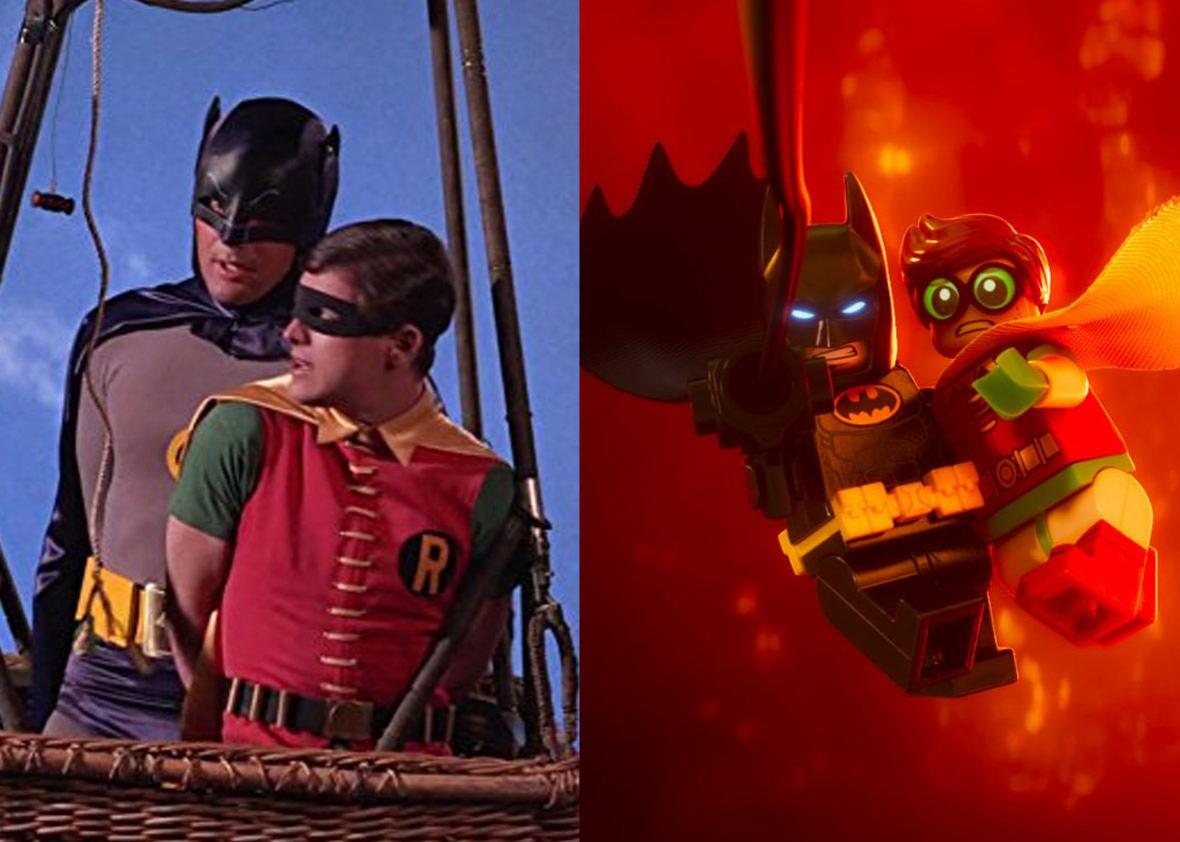Alfred the butler is worried about Bruce Wayne. He’s seen him at his wit’s end like this before—just last year, in fact. Then there was the episode he had in in 2012, the one in 2008, in 2005, in 1997, in 1995, in 1992, and in 1989, not to mention that really bad one in 1966. Prospective viewers of The Lego Batman Movie probably don’t need the accompanying visuals to get the joke: The dates of Bruce’s previous crises correspond to Batman’s previous appearances on the big screen, from Batman v. Superman: Dawn of Justice all the way back to the 1989 Tim Burton flim that established a beachhead for the new era of comic-book movie dominance.
In an age of perpetual reboots, it’s rare enough to acknowledge the incarnations that have come before; Christian Bale’s Batman never tipped his hat to Michael Keaton’s or Val Kilmer’s or George Clooney’s. But it’s that last reference, to 1966’s Batman: The Movie, and the TV series it was based on, that really sticks out. Superhero comics have spent decades running away from the campy specter of the ’60s TV show, which hung over every attempt to establish comics as a serious artistic medium like a cloud of Egghead’s laughing gas. When the dark revisionism of Watchmen and The Dark Knight Returns caught the media establishment’s attention in the mid-’80s, the response was a slew of articles with headlines like “Bam! Pow! Comics Aren’t Just for Kids Anymore!” The condescension drove adult comics fans nuts, and ever since, the Batman series’ existence has been a thorn in the sides of more sober superhero fans.
That unrelenting post-Dark Knight Returns grimness was roundly sent up in 2014’s The Lego Movie, in which Batman (voiced by Will Arnett) has the glowering countenance of an angst-ridden adolescent, blasting industrial music from his car—sample lyrics: “Darkness/ No parents”—and trying way too hard to show off his tortured soul. That’s essentially the central joke of The Lego Batman Movie as well, although it has to backtrack somewhat to allow the character an emotional arc. This Batman pretends to be a tortured tough guy because he’s a tortured softie at heart, living a life of isolation because his parents’ death has left him afraid to form new relationships. In other words, he’s a lot like every other recent version of the character.
But Lego Batman, which begins with Arnett grittily commenting on the opening titles, is steeped in self-awareness, and that includes nods to the character’s long, complicated history—all of it. When Gotham City’s mayor, Barbara Gordon (Rosario Dawson), observes that Batman has been fighting criminals for a “long, long, long, long time,” each “long” is punctuated by a flash of an iconic comic-book image, from Frank Miller’s Dark Knight cover back to the caped crusader’ earliest appearance at the hands of Bob Kane and Bill Finger. Although this Bruce Wayne appears, like most versions of the character, to be somewhere in his 30s—or at least the yellow-faced, plastic-haired equivalent thereof—his arch-nemesis, the Joker (Zach Galifianakis) drops references to their 78-year feud. (Technically, the Joker wasn’t introduced until 1940, a year after Batman’s first appearance, but the math more or less checks out.) There’s no feasible way to reconcile every one of history’s many Batmans—the movies alone have given us four different takes on the death of his parents—but Lego Batman is intent on at least admitting that they exist.
That brings us back to the TV show. The Lego Batman Movie doesn’t just reference it; it practically fetishizes it. It’s not just in the dialogue. Neal Hefti’s theme song turns up in the score, and in Patrick Stump’s opening-sequence song, “Who’s the (Bat)Man?,” where it butts up against grinding heavy-metal guitars. Even those nettlesome onscreen “sound effects” make a “Pow! Blam!” appearance. Lego Batman’s in-jokes come so thick and fast it’s hard to keep a solid count, but the TV show might be referred to more often than any other single artifact of Batmaniana. There’s a pointed perversity to the movie’s insistence, a deliberate rebuke to the idea—kept alive nowadays by dogged fans of Christopher Nolan and Zack Snyder’s movies—that Batman has always been an unrelentingly glum and humorless presence. (Among other things, it reminds us that Batman’s rogues’ gallery includes a villain called Condiment King.) But it’s also an affectionately inclusive gesture, an implicit assertion that no one version of the character supersedes the importance of all the others.
That said, it feels telling that even The Lego Batman Movie’s otherwise all-encompassing embrace skirts the existence of Batman’s (brief) appearance in Suicide Squad. Although it could be a function of timing as much as anything else, even Ben Affleck has been distancing himself from the planned standalone movie devoted to this most recent, most grindingly monotonous version of the character. Maybe Lego Batman can join the Justice League in his stead.
